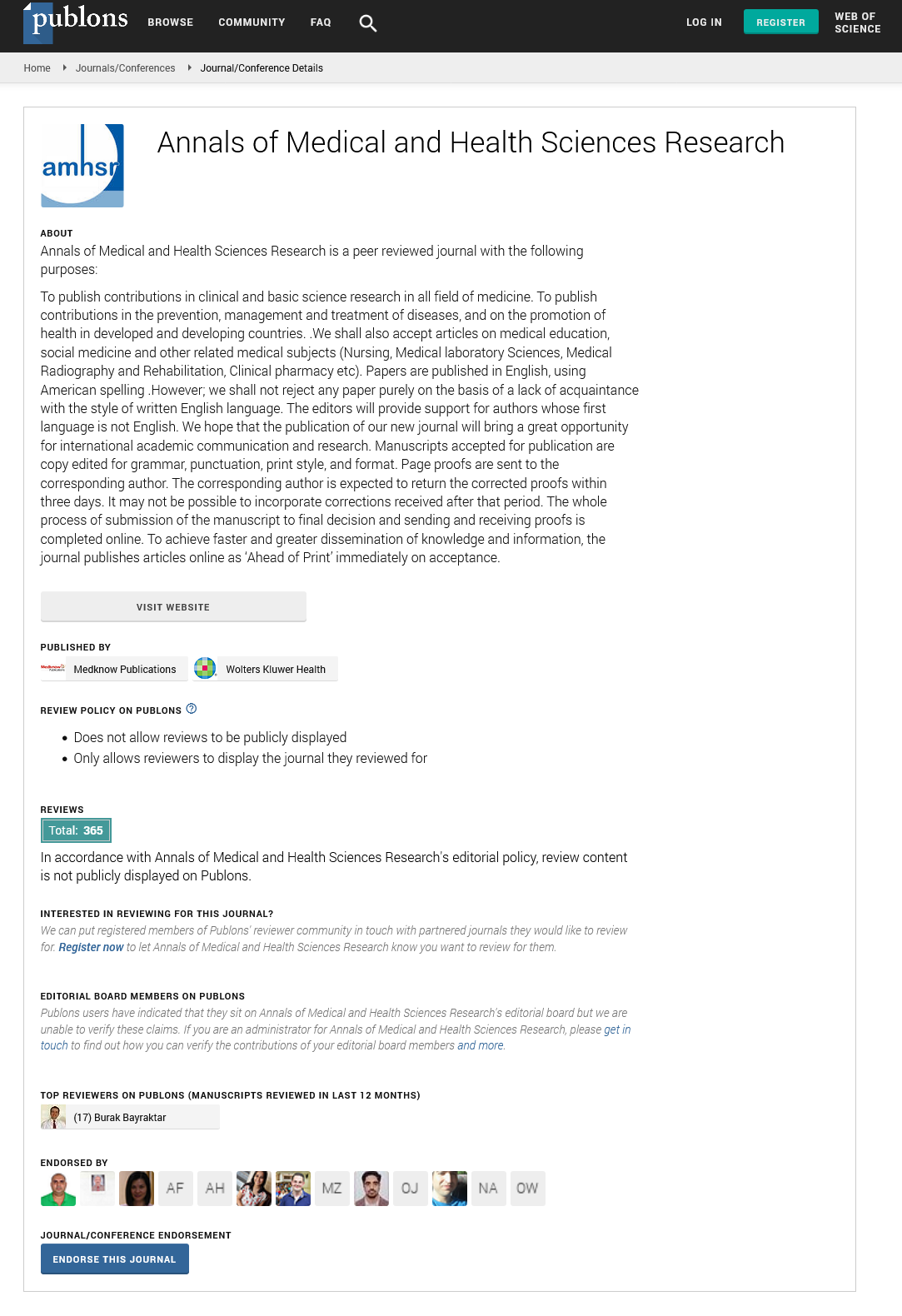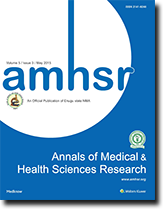Determining the Ideal Training Volume to Maximize Muscle Hypertrophy in Advanced Strength Athletes
Received: 01-Nov-2024, Manuscript No. amhsr-24-151522; Editor assigned: 04-Nov-2024, Pre QC No. amhsr-24-151522 (PQ); Reviewed: 18-Nov-2024 QC No. amhsr-24-151522; Revised: 25-Nov-2024, Manuscript No. amhsr-24-151522 (R); Published: 02-Dec-2024
Citation: Alonso KAG. Determining the Ideal Training Volume to Maximize Muscle Hypertrophy in Advanced Strength Athletes. Ann Med Health Sci Res. 2024; S4 1-2.
This open-access article is distributed under the terms of the Creative Commons Attribution Non-Commercial License (CC BY-NC) (http://creativecommons.org/licenses/by-nc/4.0/), which permits reuse, distribution and reproduction of the article, provided that the original work is properly cited and the reuse is restricted to noncommercial purposes. For commercial reuse, contact reprints@pulsus.com
Abstract
This study aims to elucidate the ideal training volume for maximizing muscle hypertrophy in advanced strength athletes through a systematic review and meta-analysis of the extant literature with high scientific hierarchy. Emphasis is placed on discerning the optimal number of weekly sets (4-10) and repetition ranges pertinent to specific muscle groups, contextualized within their fiber type compositions. Recent empirical evidence advocates for training protocols that employ higher Rate of Perceived Exertion (RPE) alongside lower overall volumes to facilitate superior hypertrophic adaptations. This paper synthesizes contemporary findings, offering evidence based guidelines tailored for advanced strength athletes and contributing to the discourse surrounding effective training methodologies.
Keywords
Hypertrophy; Training volume; Strength athletes; Systematic review; Metaanalysis; Rate of Perceived Exertion (RPE)
Introduction
Strength training is a fundamental component of athletic performance, particularly for advanced athletes aiming to achieve substantial muscle hypertrophy. Historically, training methods have emphasized high volumes. However, emerging research challenges this notion, suggesting that lower training volumes, particularly when paired with higher intensity, may yield optimal hypertrophic responses [1]. This study seeks to evaluate the relationship between training volume, muscle fiber type distribution and hypertrophy outcomes, thereby providing a pragmatic framework for strength athletes to maximize their training efficacy.
Population
The population analyzed across the referenced studies primarily consists of trained male athletes with experience in resistance training. The study samples range in size examining around 20 to 30 advanced strength athletes incorporated over 100 subjects [2]. The average age of participants is between 20 and 35 years, with most studies focusing on young adult males to minimize the variability introduced by aging on muscle hypertrophy responses. In particular, the studies in this metaanalysis emphasized resistance trained individuals who already possessed significant baseline muscle mass and strength. Over 100 male participants with at least 1 year of resistance training experience, predominantly aged between 20 years-30 years were included [2]. Around 50 participants, mainly young adult males, to analyze hypertrophic responses over varied training frequencies [3]. Thirty subjects with established strength training experience, specifically selected for their consistency in training history, to assess fiber type adaptations were examined [4]. All participants were required to maintain a stable diet and exercise routine during the study periods, ensuring that hypertrophic results could be attributed directly to the training variables rather than external lifestyle changes.
Muscle fiber types
Human skeletal muscle is characterized by distinct fiber types, each exhibiting unique physiological properties and adaptations to training stimuli. Type I fibers (slow-twitch) are predominantly utilized in endurance activities, characterized by a high oxidative capacity and fatigue resistance [4]. Type IIa fibers (fast-twitch) display a hybrid phenotype, possessing both endurance and strength capabilities, making them pivotal in resistance training contexts [5]. Type IIx fibers (fast-twitch) are primarily recruited for high intensity, explosive movements, contributing significantly to strength and power outputs. A comprehensive understanding of these fiber types is important for designing effective training regimens that maximize hypertrophic adaptations in advanced athletes.
Training volume and hypertrophy
Training volume, defined as the total amount of work performed (sets repetitions), is a key determinant of hypertrophic responses. Recent meta-analyses indicate that optimal training volumes for hypertrophy generally fall between 4-10 sets per muscle group per week [3,6]. Moreover, there is compelling evidence to support the notion that higher RPE levels during training correlate with enhanced hypertrophic outcomes. Beardsley et al., in 2019, demonstrated that athletes utilizing higher RPE approaches to training achieve greater muscle growth compared to those adhering to traditional, lower intensity methods. These findings emphasize the necessity of incorporating intensity considerations alongside volume when designing training protocols.
Literature Review
Study selection
This systematic review encompasses studies published in peer-reviewed journals that investigate the effects of training volume on muscle hypertrophy among advanced strength athletes. Inclusion criteria required studies to provide empirical data on training volume, RPE, muscle fiber composition and hypertrophy outcomes.
Data extraction and analysis
Data extraction involved compiling relevant metrics from selected studies, including sample size, training volume (measured in sets per week), hypertrophy outcomes (quantified via muscle cross-sectional area or strength gains) and reported RPE levels. Statistical analyses, including effect size calculations and hetero- geneity assessments, were performed to identify significant trends and relationships among variables.
Impact of training volume on hypertrophy
The analysis revealed that training volumes between 4 sets- 10 sets per week per muscle group were most effective in promoting hypertrophy among advanced athletes. A metaanalysis illustrating that participants performing 5 sets-10 sets per muscle group per week experienced significantly greater hypertrophic gains relative to those undertaking fewer sets [2].
Rate of Perceived Exertion (RPE) and hypertrophic response
Additionally, the relationship between RPE and hypertrophic outcomes was robust. Beardsley et al., in 2019 reported that athletes training at elevated RPE levels experienced greater muscle hypertrophy than those adhering to lower intensity training modalities. This finding is consistent with the premise that exertion levels play an important role in muscle growth adaptations.
Fiber type considerations
The impact of muscle fiber type distribution on training outcomes was also evident. Type II fibers, particularly, demonstrated a pronounced responsiveness to higher intensity and lower volume training approaches. Conversely, Type I fibers exhibited greater adaptability to higher volume endurance training, suggesting that training programs should be individualized based on the athlete’s specific muscle fiber composition. To facilitate this individualized approach, general recommendations for training each muscle group will be provided in the next figure, detailing optimal repetition ranges based on fiber type distribution [7].
This information will be summarized in an accompanying table, which outlines effective training strategies tailored to maximize hypertrophic responses for various muscle groups (Table 1).
| Muscle | Type I fibers (%) | Type IIa fibers (%) | Type IIx fibers (%) | Ideal reps range | Weekly volume (sets) |
|---|---|---|---|---|---|
| Calves (combined) | 60-80 | 15-25 | 5-10 | 6-12 | 5-8 |
| Erector spinae | 60-70 | 20-25 | 5-10 | 4-6 | 4-5 |
| Rectus abdominis | 55-60 | 20-25 | 10-20 | 4-6 | 4-5 |
| Trapezius | 55-60 | 20-25 | 15-20 | 4-6 | 5-6 |
| Latissimus dorsi | 45-55 | 25-35 | 15-20 | 4-6 | 5-6 |
| Pectoralis major | 40-55 | 25-35 | 15-25 | 4-6 | 5-6 |
| Hamstrings | 40-50 | 30-40 | 15-20 | 4-6 | 5-7 |
| Quadriceps | 50-60 | 25-30 | 10-15 | 4-6 | 5-7 |
| Gastrocnemius | 50-60 | 20-30 | 15-20 | 4-6 | 5-7 |
| Rectus femoris | 40-50 | 25-30 | 15-25 | 4-6 | 5-7 |
| Biceps brachii | 35-40 | 30-40 | 20-30 | 4-6 | 3-5 |
| Deltoid | 35-55 | 30-40 | 10-20 | 4-6 | 5-6 |
| Gluteus maximus | 40-50 | 30-40 | 15-25 | 4-6 | 5-7 |
| Triceps | 30-40 | 30-40 | 20-30 | 4-6 | 3-5 |
| Soleus | 80-90 | 5-10 | 0-5 | 6-12 | 4-6 |
Table 1: The distribution of muscle fiber types in various muscles.
Discussion
Physiological mechanisms supporting optimal repetition range
The conclusion that performing 4 to 6 repetitions per set is optimal for advanced strength athletes aiming to maximize hypertrophy is grounded in two key physiological mechanisms: The concept of effective repetitions and Hennemans size principle.
Effective repetitions theory: Recent research suggests that only the last few repetitions of each set those performed with maximal or near maximal effort are truly effective in stimulating muscle hypertrophy. These “effective repetitions” are defined as those where the muscle experiences a significant level of mechanical tension and motor unit recruitment. In lower rep ranges (4 to 6 repetitions) taken to failure or near failure, athletes are more likely to achieve around five effective repetitions per set. This optimal number is important for hypertrophy, as these final repetitions apply sufficient stimulus to activate high threshold motor units, essential for muscle growth in advanced athletes [2].
Hennemans size principle: Hennemans size principle asserts that motor units are recruited from smallest to largest as force requirements increase [8]. During high intensity, low repetition training, such as sets of 4 to 6 repetitions, the body rapidly recruits large, high threshold motor units, including those controlling fast-twitch type II muscle fibers. These fibers possess a higher growth potential than their slow-twitch type I counterparts. By training in this repetition range, advanced strength athletes can maximize activation of type II fibers, facilitating greater muscle hypertrophy and strength gains.
Furthermore, type II fibers are particularly responsive to the intense mechanical loading associated with low-repetition training, given their high force output and rapid fatigue characteristics [5]. This adaptation is important, as repeated activation of high threshold motor units under heavy loads stimulates both sarcoplasmic and myofibrillar hypertrophy, contributing to increases in muscle size and strength. When combined with sufficient recovery, these training parameters support ongoing hypertrophy without unnecessary volume, aligning with the bodys natural efficiency in adapting to high intensity stimuli. In summary, by emphasizing 4 to 6 repetitions taken to failure, this training protocol maximizes effective repetitions per set and utilizes Hennemans size principle to optimally recruit high-threshold motor units, particularly those innervating type II fibers. This approach provides a targeted, high intensity stimulus that enhances hypertrophic adaptations in advanced strength athletes.
Practical implications for strength athletes
The findings from this study suggest that advanced strength athletes should prioritize training volumes of 4 sets-10 sets per muscle group per week, emphasizing RPE to optimize hypertrophic adaptations. Coaches and athletes must tailor training programs to account for individual differences in muscle fiber distribution and personal training preferences to enhance effectiveness.
Future research directions: Future research should delve into the long term effects of varying training volumes and RPE levels on muscle fiber adaptations and overall athletic performance. Moreover, investigations into the interaction between recovery, nutrition and training volume will be essential for developing comprehensive training protocols aimed at maximizing hypertrophy.
Conclusion
This study provides compelling evidence that advanced strength athletes can achieve significant muscle hypertrophy through tailored training volumes of 4 sets-10 sets per muscle group per week as a general recommendation, complemented by higher RPE levels, ideally around the rates of 8 to 9. However, further analysis suggests that the optimal training volume may actually be somewhat lower, ideally between 4 sets-6 sets per muscle group. This adjustment aligns with the principle of effective repetitions, emphasizing the importance of quality over quantity in strength training. In practical terms, when an athlete performs a set with a specific weight, the velocity of the repetitions can serve as a key indicator of training intensity and effectiveness. For example, if the first repetition of a set is completed at a velocity equal X and the second repetition concentric phase execution time happens to be longer than X. Consequently, this indicates that failure will likely be reached within the 4 to 6 repetition range which is the ideal, confirming that the weight is appropriately selected for the intended training stimulus.
This decline in velocity suggests that the athlete is approaching failure and is starting to recruit the higher threshold motor units, specially in type II muscle fibers, which are typically activated during short high intensity efforts. This transition is important, as the activation of these motor units plays a significant role in stimulating myofibrillar muscle hypertrophy, particularly for type IIx muscle fibers, which have the greatest potential to achieve type of hypertrophy. The recruitment of higher threshold motor units facilitates increased active mechanical tension within the muscle fibers, thereby promoting greater mechanical stress and metabolic demand. Moreover, this dynamic recruitment pattern illustrates the importance of selecting appropriate weights for training. By ensuring that the resistance is sufficiently challenging, athletes can effectively engage both low and high threshold motor units throughout their sets because when reaching failure, every type of muscle fiber and motor unit will be activated. This strategic approach not only helps to optimize hypertrophic responses but also fosters greater adaptation to the training stimulus, ultimately leading to improved performance outcomes in strength athletes.
Furthermore, achieving a true RPE of 9 or a Repetitions in Reserve (RIR) of 0 is often a challenging endeavor in practical settings. The complexities inherent in standardizing training regimens highlight the variability in individual responses to different training stimuli. Some athletes may find it difficult to consistently push themselves to the brink of mechanical failure, which can hinder progress and adaptation. Therefore, using velocity-based training metrics can be an effective strategy for coaches and athletes alike, allowing for real-time adjustments to training loads based on performance feedback. By gaining a deeper understanding of muscle fiber types and their specific responses to varying training regimens, athletes can more effectively structure their training programs. This knowledge enables them to optimize muscle growth outcomes by strategically manipulating volume, intensity and rest periods to align with their individual physiological responses. Ultimately, the integration of these principles can lead to more informed training decisions, enhancing both performance and muscle hypertrophy in advanced strength athletes.
References
- Schoenfeld BJ, Ogborn D, Krieger JW. Effects of resistance training frequency on measures of muscle hypertrophy: A systematic review and meta-analysis. Sports Med. 2016; 46(11):1689-1697.
- Schoenfeld BJ, Ogborn DI, Vigotsky AD, Franchi MV, Krieger JW. Hypertrophic effects of concentric vs. eccentric muscle actions: A systematic review and meta-analysis. J Strength Cond Res. 2017; 31(9):2599-2608.
- Schoenfeld BJ, Peterson MD, Ogborn D, Contreras B, Sonmez GT. Effects of low vs. high load resistance training on muscle strength and hypertrophy in well-trained men. J Strength Cond Res. 2015; 29(10):2954-2963.
- Baar K. Nutrition and the adaptation to endurance training. Sports Med. 2014; 44:5-12.
- Coyle EF. Substrate utilization during exercise in active people. Am J Clin Nutr. 1995; 61(4):968S-79S.
- Schoenfeld BJ. The mechanisms of muscle hypertrophy and their application to resistance training. The J Strength Cond Res. 2010; 24(10):2857-2872.
[Crossref] [Google Scholar] [PubMed]
- Gollnick PD, Armstrong RB, Saltin B, Saubert CW, Sembrowich WL, et al. Effect of training on enzyme activity and fiber composition of human skeletal muscle. J Appl Physiol. 1973; 34:107-111.
[Crossref] [Google Scholar][PubMed]
- Henneman E. Relation between size of neurons and their susceptibility to discharge. Science. 1957; 126:1345-1347.




 The Annals of Medical and Health Sciences Research is a monthly multidisciplinary medical journal.
The Annals of Medical and Health Sciences Research is a monthly multidisciplinary medical journal.